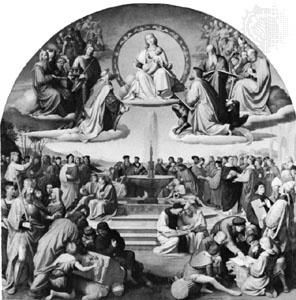Nazarene
Christianity
in the New Testament, a title applied to Jesus and, later, to those who followed his teachings (Acts 24:5). In the Greek text there appear two forms of the word: the simple form, Nazarēnos, meaning “of Nazareth,” and the peculiar form, Nazōraios. Before its association with the locality, this latter term may have referred to a Jewish sect of “observants,” or “devotees,” and was later transferred to the Christians.
The term Nazarene is also applied to a Syrian Judeo-Christian sect of the 4th century AD. Although they accepted the divinity of Christ and his supernatural birth, the Nazarenes also maintained strict observance of Jewish laws and customs, a practice that had been dropped by the majority of Jewish Christians. They used a version of the Gospel in Aramaic called the Gospel According to the Hebrews, or the Gospel of the Nazarenes. Their relation to the Judeo-Christian sect of the Ebionites remains uncertain.
Arabs and Jews today employ the word Nazarene as a general designation for those of the Christian faith.
German art society
member of Lucas Brotherhood, or Brotherhood of Saint Luke, German Nazarener, or Lukasbund
 one of an association formed by a number of young German painters in 1809 to return to the medieval spirit in art. Reacting particularly against 18th-century Neoclassicism, the brotherhood was the first effective antiacademic movement in European painting. The Nazarenes believed that all art should serve a moral or religious purpose; they admired painters of the late Middle Ages and early Renaissance and rejected most subsequent painting (promulgated by the European academies), believing that it abandoned religious ideals in favour of artistic virtuosity. They also thought that the mechanical routine of the academy system could be avoided by a return to the more intimate teaching situation of the medieval workshop. For this reason, they worked and lived together in a semimonastic existence.
one of an association formed by a number of young German painters in 1809 to return to the medieval spirit in art. Reacting particularly against 18th-century Neoclassicism, the brotherhood was the first effective antiacademic movement in European painting. The Nazarenes believed that all art should serve a moral or religious purpose; they admired painters of the late Middle Ages and early Renaissance and rejected most subsequent painting (promulgated by the European academies), believing that it abandoned religious ideals in favour of artistic virtuosity. They also thought that the mechanical routine of the academy system could be avoided by a return to the more intimate teaching situation of the medieval workshop. For this reason, they worked and lived together in a semimonastic existence.The brotherhood's original members were six Vienna Academy students. Four of them, Friedrich Overbeck (Overbeck, Johann Friedrich), Franz Pforr, Ludwig Vogel, and Johann Konrad Hottinger, moved in 1810 to Rome, where they occupied the abandoned monastery of Sant'Isidoro. There they were joined by Peter von Cornelius (Cornelius, Peter von), Wilhelm von Schadow, and others who at various times were associated with the movement. They soon acquired the originally derisive nickname Nazarenes because of their affectation of biblical style of hair and dress. The major project of the Nazarenes was to revive the medieval art of fresco painting. They were fortunate in receiving two important commissions, the fresco decoration of the Casa Bartholdy (1816–17) and the Casino Massimo (1817–29) in Rome, which brought their work to international attention. By the time of the completion of the Casino Massimo frescoes, all except Overbeck had returned to Germany and the group had dissolved.
The art of the Nazarenes, consisting largely of religious subjects executed in a conventional naturalistic style, was, for the most part, unimpressive, characterized by overcrowded compositions, overattention to detail, and lack of colouristic or formal vitality. Nevertheless, their aim of honest expression of deeply felt ideals had an important influence on subsequent movements, particularly the English Pre-Raphaelites of the mid-19th century. See also Pre-Raphaelite Brotherhood.
- André-Ernest-Modeste Grétry
- André-Eugène Blondel
- André F. Cournand
- André Gide
- André Gill
- André-Gustave Citroën
- André-Hercule de Fleury
- André-Jacques Garnerin
- André Jeanbon Saint-André
- André, John
- André Jolivet
- André Kertész
- André Le Chapelain
- André Le Nôtre
- André Lhote
- André-Louis Danjon
- André Lwoff
- André Maginot
- André Malraux
- André-Marie Ampère
- André Masson
- André Maurois
- André Messager
- André Michaux
- André Morellet